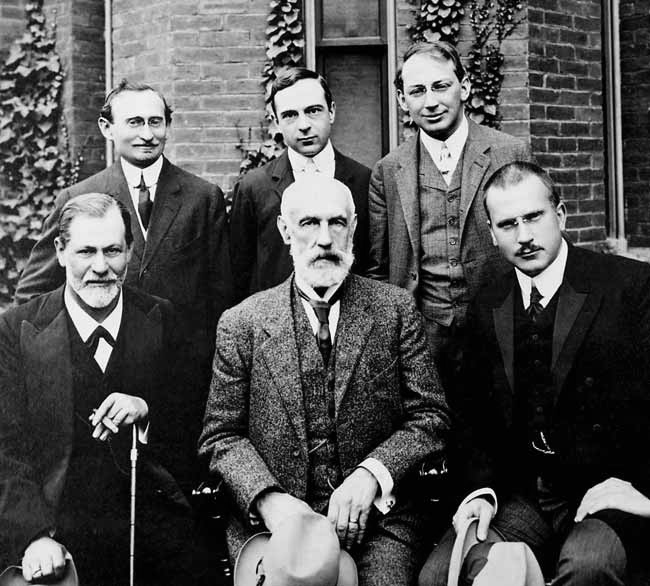 |
| Carl Jung (front row, far right) and Sigmund Freud (front row far left) |
The Pearson-Marr Archetype Indicator (PMAI), designed by Carol Pearson and Hugh Marr, is an assessment tool based on both Carl Jung's archetypes (see my entry for J) and Joseph Campbell's works on mythology (specifically The Hero With A Thousand Faces).
Carl Jung, one of the most influential founders of modern psychology, built on the concept of the archetype - a collectively inherited pattern of myths, legends, themes, characters, and symbols which make up our individual psyches and cultures.
Joesph Campbell theorized that ancient myths from around the world all contain basic elements of the Hero who sets out upon a Journey, survives danger, performs tasks, receives a gift or gifts (if he survives), then chooses whether to return or not and share those gifts, one of which is usually some sort of enlightenment. (This is an extremely simplistic description, but I wish to keep these posts brief.)
The test consists of 72 questions with a choice of five responses: 1 Strongly Disagree, 2 Disagree, 3 Neutral, 4 Agree, 5 Strongly Agree.
Scores are then totaled for each of the archetypes and scaled on a circular chart. The PMAI is designed to assess the type/strength of archetypes at a given moment of the test subject's life.
Unlike many other theories and assessments which assume that a person's core personality is somewhat fixed, the PMAI results may change over time since the subject is on a life journey and different archetypes may be stronger or "active" at different points of that journey.
PMAI archetypes here
Questions to ask about your character using the PMAI:
- What sort of life journey have you set for your character?
- If you are concerned with only a portion of the character's life, which archetype is strongest during that period? Which might have been strongest in the past?
- How might your character's particular culture have influenced his archetype?
- How does archetype influence how your character views the world and others around him?
- Is your character aware of her particular archetype? (Is she an "orphan" type who recognizes and embraces the fact that she is a tough survivor, or does she subsume that type in favor of appearing more fragile and feminine?)
- Everyone has "shadow" archetypes (scored lowest on the test). These archetypes (if desired) can be nurtured and strengthened by an individual over time. What might your character's shadow archetypes be? Will those archetypes emerge as your story unfolds? Or will your character remain essentially unchanged over his journey?
Your research in this series is amazing. I'm learning a lot. Thanks Lisa.
ReplyDeleteI'll have to bookmark that and take the test.
ReplyDeleteThere are so many ways to find out more about your characters. This assessment tool is neat. I'd like to take the test for myself. ;)
ReplyDeleteI've always found Campbell's work fascinating partly because myths fascinate me, and Campbell provides thoughtful insight into character building. His work was brought up in several of my history and writing classes back in university.
ReplyDelete